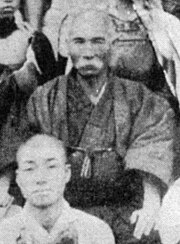Anko Itosu
| Ankō Itosu | |
|---|---|
 |
|
| Born | 1831 Gibo Village, Shuri, Ryūkyū Kingdom |
| Died | 11 March 1915 (aged 83–84) Shuri, Okinawa, Japan |
| Other names | Itosu Yasutsune |
| Style | Shorin-ryu, Shuri-te |
| Teacher(s) | Nagahama Chikudun of Naha, Sokon Matsumura |
| Notable students | Choyu Motobu, Choki Motobu, Kentsu Yabu, Chomo Hanashiro, Gichin Funakoshi, Moden Yabiku, Kanken Toyama, Shinpan Gusukuma (Shiroma), Anbun Tokuda, Kenwa Mabuni, Chōshin Chibana, Chojun Miyagi |
Ankō Itosu (糸洲 安恒 Okinawan: Ichiji Ankō?, Japanese: Itosu Ankō, 1831 – 11 March 1915) is considered by many the father of modern karate, although this title is also often given to Gichin Funakoshi because the latter spread karate throughout Japan.
Itosu was born in 1831 and died in 1915. A low-rank Ryūkyūan Pechin, Itosu was small in stature, shy, and introverted as a child. He was raised in a strict home of the keimochi (a family of position), and was educated in the Chinese classics and calligraphy. Itosu began his tode (karate) study under Nagahama Chikudun Pechin. His study of the art led him to Sokon Matsumura. Part of Itosu's training was makiwara practice. He once tied a leather sandal to a stone wall in an effort to build a better makiwara. After several strikes, the stone fell from the wall. After relocating the sandal several times, Itosu had destroyed the wall.
Itosu served as a secretary to the last king of the Ryūkyū Kingdom until Japan abolished the Okinawa-based native monarchy in 1879. In 1901, he was instrumental in getting karate introduced into Okinawa's schools. In 1905, Itosu was a part-time teacher of To-te at Okinawa's First Junior Prefectural High School. It was here that he developed the systematic method of teaching karate techniques that are still in practice today. He created and introduced the Pinan forms (Heian in Japanese) as learning steps for students, because he felt the older forms (kata in Japanese) were too difficult for schoolchildren to learn. The five Pinan forms were (allegedly) created by drawing from two older forms: kusanku and chiang nan. Itosu is also credited with taking the large Naihanchi form (tekki in Japan) and breaking it into the three well-known modern forms Naihanchi Shodan, Naihanchi Nidan, and Naihanchi Sandan. In 1908, Itosu wrote the influential "Ten Precepts (Tode Jukun) of Karate," reaching beyond Okinawa to Japan. Itosu's style of karate, Shorin-ryu, came to be known as Itosu-ryu in recognition of his skill, mastery, and role as teacher to many.
...
Wikipedia
